by Jefferson dos Santos Estevo* (Advanced Biofuels USA) In the third Webinar, the theme was one of the most promising alternatives for mitigating greenhouse gas emissions, not only for civil aviation but in different areas: Power-to-X (PT-X) technology. Before the speakers, an explanatory video about the technology's functioning was shown.
Power-to-X
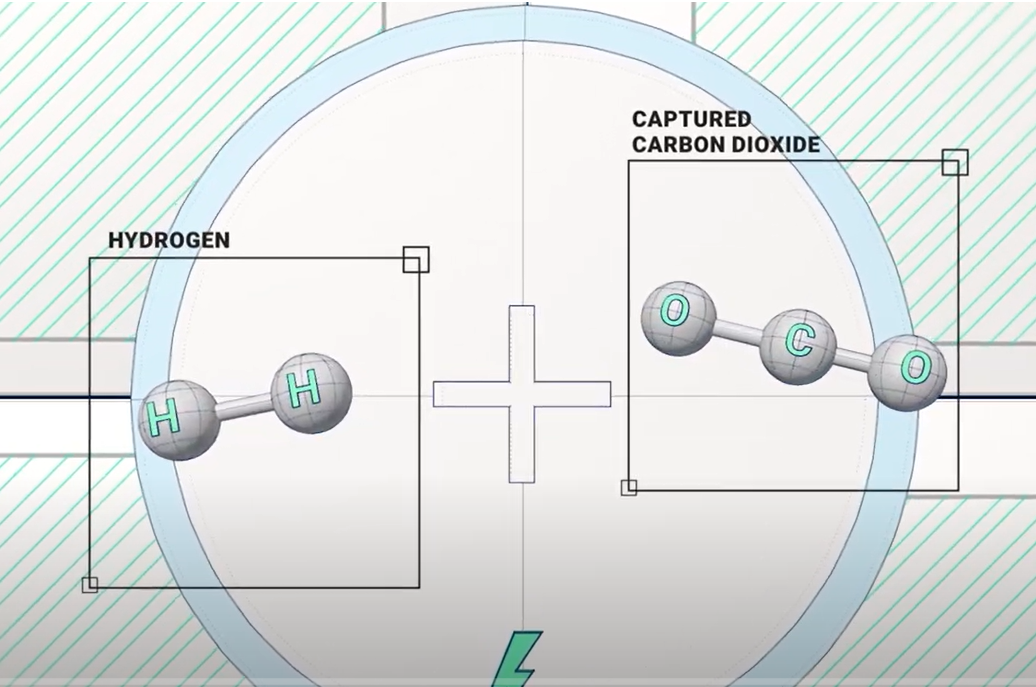 In general terms, this technology transforms water and CO² into renewable fuels. To do so sustainably, a renewable energy source—such as solar, wind, or biomass—is used to split water molecules (H²O) into Hydrogen and Oxygen. For Power-to-X, that hydrogen is then combined with captured carbon ( CO²). Hydrogen obtained through electrolysis can also be used in various industrial processes, such as the production of SAF.
In general terms, this technology transforms water and CO² into renewable fuels. To do so sustainably, a renewable energy source—such as solar, wind, or biomass—is used to split water molecules (H²O) into Hydrogen and Oxygen. For Power-to-X, that hydrogen is then combined with captured carbon ( CO²). Hydrogen obtained through electrolysis can also be used in various industrial processes, such as the production of SAF.
It is important to highlight that the process can be carried out with any energy, even non-renewable sources. It is used to split water molecules (H²O) into hydrogen and oxygen. To reduce the carbon footprint, renewable energy sources such as solar, wind, hydropower or biomass can be used, which helps aviation decarbonization in the production of sustainable fuel. To better explain this technology, three speakers were chosen.
Market Forces
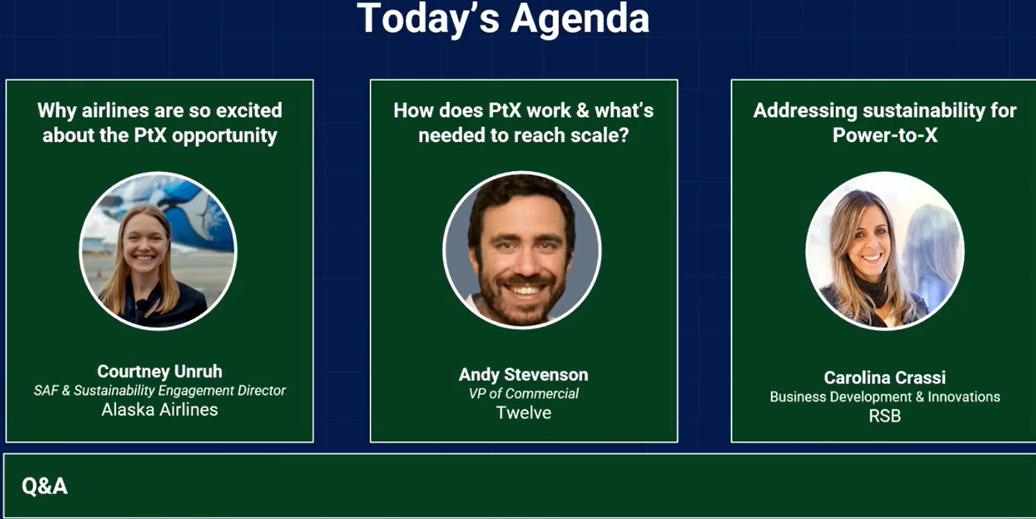 As in the previous two webinars, the host was Hannah Walker from RSB, who introduced Courtney Unruh from Alaska Airlines. In her presentation, Unruh demonstrated how the company is addressing emission reductions, with a goal of using up to 10% SAF in its flights by 2030 and achieving net-zero emissions by 2040. To this end, the company has been collaborating on research in the area, establishing a partnership with Twente and Microsoft, which resulted in a plant in Moses Lake, Washington, set to begin supplying SAF to the company in 2025.
As in the previous two webinars, the host was Hannah Walker from RSB, who introduced Courtney Unruh from Alaska Airlines. In her presentation, Unruh demonstrated how the company is addressing emission reductions, with a goal of using up to 10% SAF in its flights by 2030 and achieving net-zero emissions by 2040. To this end, the company has been collaborating on research in the area, establishing a partnership with Twente and Microsoft, which resulted in a plant in Moses Lake, Washington, set to begin supplying SAF to the company in 2025.
In the context of PT-X, Unruh highlighted the importance of this technology for airlines, indicating that all alternatives for SAF production are essential, as there is a demand that will increase in the coming years. For this particular technology, it is highly sustainable, uses more abundant raw materials - CO² and H²O - and has greater ease of production, with smaller plants.
Feedstock and Process
The second speaker was Andy Stevenson from Twelve, who had the challenging task of better explaining PT-X technology. This technology has an advantage over other pathways due to the greater availability of raw materials, making it an important alternative to meet future demand, given its scalable production capacity.
 First of all, Stevenson explained the different PT-X technologies, production methods, and uses, which generally uses CO² as a raw material and a renewable energy source.
First of all, Stevenson explained the different PT-X technologies, production methods, and uses, which generally uses CO² as a raw material and a renewable energy source.
The first is the Reverse Water Gas Shift (RWGS), currently the most used, as the underlying technology is already employed by industries. In summary, as explained in the opening video, H² is produced, which can ultimately be used for SAF; the main difficulty is the high energy consumption, which, to meet sustainability goals, must come from low carbon intensity sources.
The second is Methanol to Jet (MtJ), whose biggest challenge is the process costs, still under development. In the brief explanation, methanol is produced from the gasification of biomass and waste, as well as low-carbon hydrogen and captured carbon dioxide (CO), which can be converted and used for SAF production.
Twelve is a company specialized in the third technology, CO² Electrolysis, which uses the most energy among them all, posing a challenge in a world still in energy transition. Basically, its operation involves using renewable energy to produce H², followed by a biological synthesis gas process to produce an ethanol intermediate. This goes through a thermocatalytic ethanol upgrade step to produce the final SAF product.
Finally, the Solid Oxide Electrolyzer Cell (SOEC), which is in the early stages of development by various companies, operates similarly but uses high temperatures.
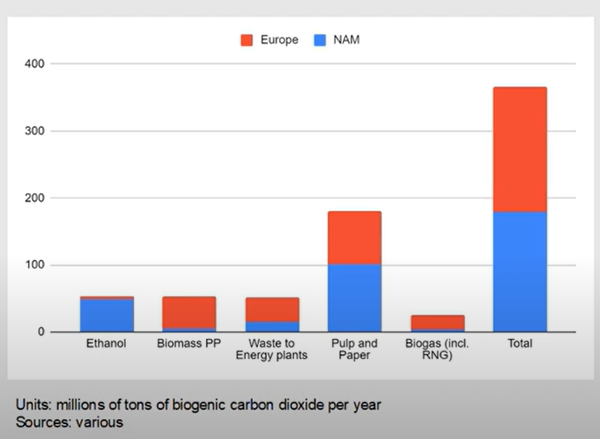 Stevenson then explained the raw material, generally CO², derived from biomass. There is a potential for an annual production of 38 billion gallons per year, with the raw material available in North America and Europe.
Stevenson then explained the raw material, generally CO², derived from biomass. There is a potential for an annual production of 38 billion gallons per year, with the raw material available in North America and Europe.
The pulp and paper industries present the best scenarios for supply of feedstock, mostly in Europe. According to him, there is competition in the market for this raw material, which hinders the increase in SAF production, turning this type of CO² into a commodity.
Last, Stevenson highlighted the importance of this technology, not only for the SAF sector but also for others, such as the defossilization of the chemical sector. Thus, it is a new technology that involves different, also innovative, processes that, combined and advancing, will be essential for mitigating emissions and consequently combating climate change.
Certifying Sustainability
The last participant, as occurred in the previous instances, is a representative from RSB, who also comments on the sustainability of the process, the "S" in SAF. This time, Carolina Grassi, manager of business and innovation, was chosen. For her, this is a technology termed 4-D, involving: Decarbonizing, Dense, Disruptive, and Diverse. The first, as it is clear, concerns the use of CO² in the process, which will be used for high and density energy manufacturing, the third for being a technology with global raw materials, and the last for the diversity of productions at its end.
 Next, Grassi discusses the sustainability of the entire process, divided into three parts: energy generation, production, and applications.
Next, Grassi discusses the sustainability of the entire process, divided into three parts: energy generation, production, and applications.
Initially, it is of paramount importance that the energy source is non-fossil. In the second, the importance of water for H² production, its sources, whether there is waste, its social impact, etc.; and also, the origin of the CO² that will be used in the conversion. Finally, sustainability relates to how the final results will be utilized, such as the amount of emission reductions, for example with SAF. It is important to note that hydrogen might be obtained from other sustainable feedstock and processes in addition to electrolysis of water.
As explained in previous webinars, RSB and other certifiers seek to assess the entire SAF manufacturing process, which is no different in this pathway, considering environmental and social issues, in other words, sustainability.
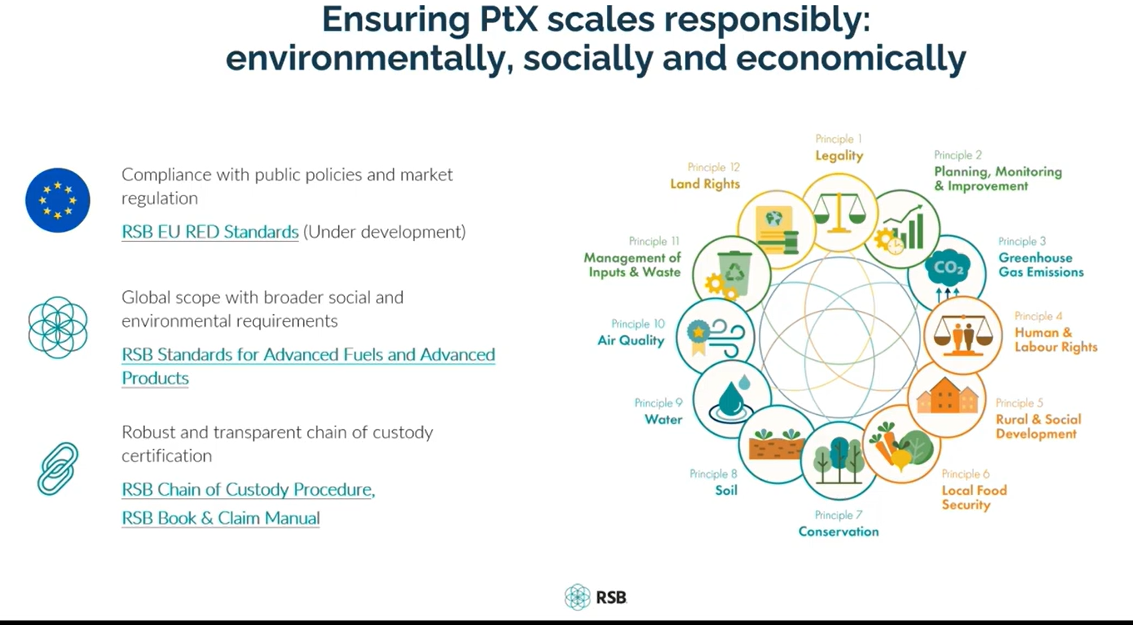 Subsequently, certifications are generated, which differ for each activity and degree of sustainability. In terms of electricity, RSB considers it relevant that it be renewable, with two possibilities. Connected directly to the grid, with 90% from renewable sources, or with its own installation, with active production for a minimum of 3 years. In other words, there are various analyses regarding electricity, different criteria are evaluated.
Subsequently, certifications are generated, which differ for each activity and degree of sustainability. In terms of electricity, RSB considers it relevant that it be renewable, with two possibilities. Connected directly to the grid, with 90% from renewable sources, or with its own installation, with active production for a minimum of 3 years. In other words, there are various analyses regarding electricity, different criteria are evaluated.
Regarding CO² , it can be of biogenic, non-biogenic, or capture origin.The sources, in the case of the former, must be evaluated in the same way as the capture process was conducted. It is also important to identify that the CO² from the process did not receive any reduction count, avoiding double counting. Next, Grassi emphasizes the importance of the water used in the process, which, as indicated, must have its origin understood, its disposal, social involvement, waste, etc.
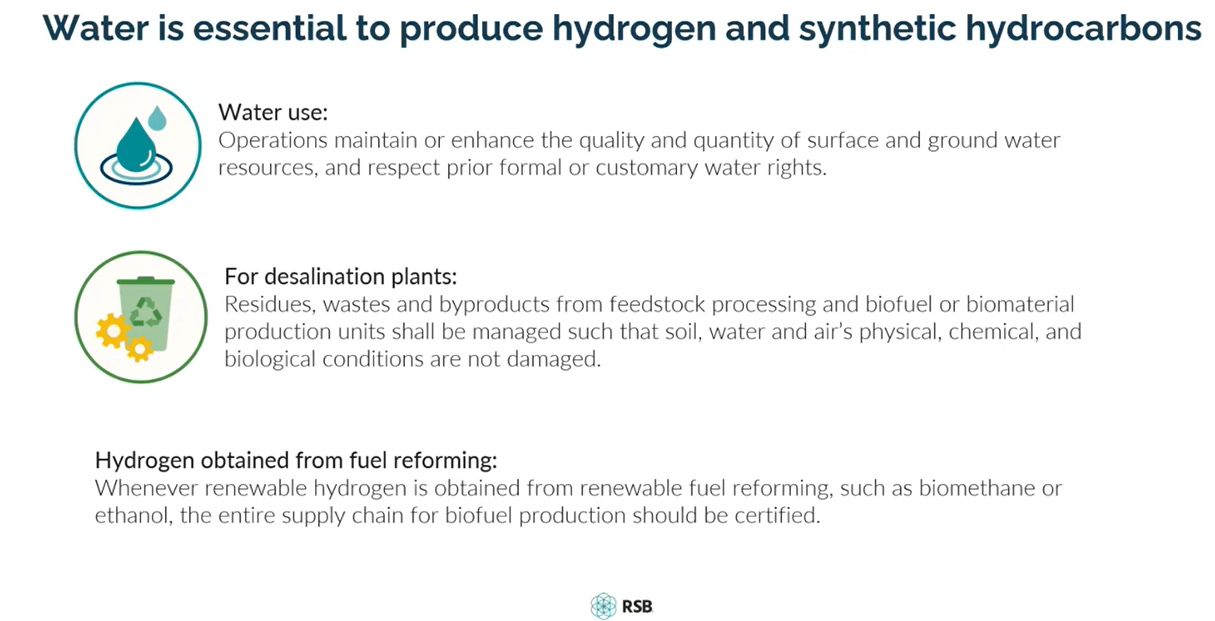 Finally, she describes in a more comprehensive way the certificates or Renewable Fuels of Non-Biological Origin (RFNBO) from the PT-X process. These must reduce emissions by at least 70% compared to fossil fuels, in relation to the production chain previously mentioned. Furthermore, this count must be carried out by companies using recognized and respected methodologies.
Finally, she describes in a more comprehensive way the certificates or Renewable Fuels of Non-Biological Origin (RFNBO) from the PT-X process. These must reduce emissions by at least 70% compared to fossil fuels, in relation to the production chain previously mentioned. Furthermore, this count must be carried out by companies using recognized and respected methodologies.
In general, this presentation addressed the potential of PT-X technology for SAF. It has enormous potential, as its main raw material is CO² derived from biomass, which is generally an underutilized source. However, renewable sources of electricity must be used, which is a challenge for some countries. This is an important alternative, still in its early stages, but it will be essential to meet the fuel demand in the coming years.
Power-to-X: A new technology for SAF Short VIDEO
Watch presentation: https://www.youtube.com/watch?v=Rpr81taU1wU
*Post-doctoral researcher in Political Science at the Federal University of Goias, Brazil. Fellow of CNPQ and FAPEG jeffersonestevo@ufg.br
Related articles
- Twelve Launches "Fuel for the Long Haul" Campaign Setting a New Standard for Sustainable Aviation (Twelve Benefit Corporation)
Excerpt from Twelve Benefit Corporation: Carbon Transformation Company Presents E-Jet® SAF as the Future of Fossil-Free Aviation Fuel in Multichannel Brand Campaign -- - Twelve™, the carbon transformation company that turns CO2 into products, today (June 18, 2024) announced the launch of its "Fuel for the Long Haul™" brand campaign introducing an industry-first breakthrough technology and the company's first market offering, E-Jet® Sustainable Aviation Fuel (SAF).
Twelve's E-Jet® is an e-SAF, which is a fuel made from CO2, water, and renewable energy, resulting in up to 90% lower lifecycle emissions compared with conventional jet fuel. e-SAFs use up to 1,000 times less water and 30 times less land than biofuels and other SAF options on the market.
"Fuel for the Long Haul" is a multichannel brand campaign that celebrates a bold new standard for aviation's sustainable future by introducing the world to E-Jet® SAF. The campaign will appear in out-of-home advertising, print, digital, installations, and via both online and in-person events to advance education and dialogue among industry leaders and travelers alike.
Since its inception in 2015, Twelve has established itself as a pioneer in climate tech, working to build a fossil-free future through the science of carbon transformation and electrochemistry. With the imminent debut of E-Jet® SAF, the company's partnerships with leaders of industry, such as International Airlines Group (IAG) and British Airways, Alaska Airlines, Microsoft, Shopify, SABA, Boston Consulting Group, and Etihad Airways, paired with its numerous accolades and industry achievements – including World Economic Forum and UpLink Sustainable Aviation Challenge winner (2024), MIT's 15 Climate Tech Companies to Watch (2023), and TIME Best Inventions (2022), among others – demonstrate the impact and credibility of Twelve's ongoing work within the sector.
"We have a roadmap to achieve net zero by 2050 including a target to fly with 10% Sustainable Aviation Fuel by 2030," said Luis Gallego, CEO of IAG. "The shortage of sustainable fuel globally continues to be a problem for our industry although innovative companies like Twelve are an important part of the solution."
Global aviation will consume nearly 100 billion gallons of fuel this year alone due to the resurgence of tourism, emitting nearly 1 billion tons of CO2. With an increased worldwide focus on reducing emissions, both the U.S. and E.U. have set ambitious targets for SAF production and use via the landmark 2022 Inflation Reduction Act, follow-on state legislation, and the E.U.'s own SAF mandate, signaling strong market demand and regulatory support for the industry. While SAF is critical to decarbonizing aviation, E-Jet® leads the charge with up to 90% lower lifecycle emissions, as not all SAF delivers equal decarbonization impact.
"Aviation sits at the center of the global supply chain and holds the power to connect each of us with our customers and loved ones," said Nicholas Flanders, CEO and Co-Founder of Twelve. "Innovation, connection, and education are at the heart of the 'Fuel for the Long Haul' campaign and E-Jet® fuel represents more than just a product. It symbolizes our larger commitment to creating a fossil-free future made possible by the incredible potential of carbon transformation technology. This campaign is about celebrating our milestones and, more urgently, rallying industry to join us in this critical mission."
Twelve invites industry stakeholders and everyday travelers alike to join the movement towards sustainable aviation through education on this breakthrough technology. Discover more about E-Jet® SAF and the "Fuel for the Long Haul" campaign by visiting www.twelve.co/ejet.
About Twelve:
Twelve™ is the carbon transformation company. We're on a mission to eliminate global emissions and build a fossil-free future. Carbon transformation uses CO2 to displace fossil fuels as a feedstock. Opus™, Twelve's revolutionary carbon transformation technology, works like industrial photosynthesis. It transforms CO2, water, and renewable energy into hydrocarbons, the building blocks for essential chemicals, materials, and fuels. Twelve can make the same chemicals, materials, and fuels from CO2 that are conventionally made from fossil fuels. Learn more at www.twelve.co. READ MORE
Nearly 55,000 articles in our online library!
Use the categories and tags listed below to access the nearly 50,000 articles indexed on this website.
Advanced Biofuels USA Policy Statements and Handouts!
- For Kids: Carbon Cycle Puzzle Page
- Why Ethanol? Why E85?
- Just A Minute 3-5 Minute Educational Videos
- 30/30 Online Presentations
- “Disappearing” Carbon Tax for Non-Renewable Fuels
- What’s the Difference between Biodiesel and Renewable (Green) Diesel? 2020 revision
- How to De-Fossilize Your Fleet: Suggestions for Fleet Managers Working on Sustainability Programs
- New Engine Technologies Could Produce Similar Mileage for All Ethanol Fuel Mixtures
- Action Plan for a Sustainable Advanced Biofuel Economy
- The Interaction of the Clean Air Act, California’s CAA Waiver, Corporate Average Fuel Economy Standards, Renewable Fuel Standards and California’s Low Carbon Fuel Standard
- Latest Data on Fuel Mileage and GHG Benefits of E30
- What Can I Do?
Donate
DonateARCHIVES
- December 2025
- November 2025
- October 2025
- September 2025
- August 2025
- July 2025
- June 2025
- May 2025
- April 2025
- March 2025
- February 2025
- January 2025
- December 2024
- November 2024
- October 2024
- September 2024
- August 2024
- July 2024
- June 2024
- May 2024
- April 2024
- March 2024
- February 2024
- January 2024
- December 2023
- November 2023
- October 2023
- September 2023
- August 2023
- July 2023
- June 2023
- May 2023
- April 2023
- March 2023
- February 2023
- January 2023
- December 2022
- November 2022
- October 2022
- September 2022
- August 2022
- July 2022
- June 2022
- May 2022
- April 2022
- March 2022
- February 2022
- January 2022
- December 2021
- November 2021
- October 2021
- September 2021
- August 2021
- July 2021
- June 2021
- May 2021
- April 2021
- March 2021
- February 2021
- January 2021
- December 2020
- November 2020
- October 2020
- September 2020
- August 2020
- July 2020
- June 2020
- May 2020
- April 2020
- March 2020
- February 2020
- January 2020
- December 2019
- November 2019
- October 2019
- September 2019
- August 2019
- July 2019
- June 2019
- May 2019
- April 2019
- March 2019
- February 2019
- January 2019
- December 2018
- November 2018
- October 2018
- September 2018
- August 2018
- July 2018
- June 2018
- May 2018
- April 2018
- March 2018
- February 2018
- January 2018
- December 2017
- November 2017
- October 2017
- September 2017
- August 2017
- July 2017
- June 2017
- May 2017
- April 2017
- March 2017
- February 2017
- January 2017
- December 2016
- November 2016
- October 2016
- September 2016
- August 2016
- July 2016
- June 2016
- May 2016
- April 2016
- March 2016
- February 2016
- January 2016
- December 2015
- November 2015
- October 2015
- September 2015
- August 2015
- July 2015
- June 2015
- May 2015
- April 2015
- March 2015
- February 2015
- January 2015
- December 2014
- November 2014
- October 2014
- September 2014
- August 2014
- July 2014
- June 2014
- May 2014
- April 2014
- March 2014
- February 2014
- January 2014
- December 2013
- November 2013
- October 2013
- September 2013
- August 2013
- July 2013
- June 2013
- May 2013
- April 2013
- March 2013
- February 2013
- January 2013
- December 2012
- November 2012
- October 2012
- September 2012
- August 2012
- July 2012
- June 2012
- May 2012
- April 2012
- March 2012
- February 2012
- January 2012
- December 2011
- November 2011
- October 2011
- September 2011
- August 2011
- July 2011
- June 2011
- May 2011
- April 2011
- March 2011
- February 2011
- January 2011
- December 2010
- November 2010
- October 2010
- September 2010
- August 2010
- July 2010
- June 2010
- May 2010
- April 2010
- March 2010
- February 2010
- January 2010
- December 2009
- November 2009
- October 2009
- September 2009
- August 2009
- July 2009
- June 2009
- May 2009
- April 2009
- March 2009
- February 2009
- January 2009
- December 2008
- November 2008
- October 2008
- September 2008
- August 2008
- July 2008
- June 2008
- May 2008
- April 2008
- March 2008
- February 2008
- January 2008
- December 2007
- November 2007
- October 2007
- September 2007
- August 2007
- June 2007
- February 2007
- January 2007
- October 2006
- April 2006
- January 2006
- April 2005
- December 2004
- November 2004
- December 1987
CATEGORIES
- About Us
- Advanced Biofuels Call to Action
- Aviation Fuel/Sustainable Aviation Fuel (SAF)
- BioChemicals/Renewable Chemicals
- BioRefineries/Renewable Fuel Production
- Business News/Analysis
- Cooking Fuel
- Education
- 30/30 Online Presentations
- Competitions, Contests
- Earth Day 2021
- Earth Day 2022
- Earth Day 2023
- Earth Day 2024
- Earth Day 2025
- Executive Training
- Featured Study Programs
- Instagram TikTok Short Videos
- Internships
- Just a Minute
- K-12 Activities
- Mechanics training
- Online Courses
- Podcasts
- Scholarships/Fellowships
- Teacher Resources
- Technical Training
- Technician Training
- University/College Programs
- Events
- Coming Events
- Completed Events
- More Coming Events
- Requests for Speakers, Presentations, Posters
- Requests for Speakers, Presentations, Posters Completed
- Webinars/Online
- Webinars/Online Completed; often available on-demand
- Federal Agency/Executive Branch
- Agency for International Development (USAID)
- Agriculture (USDA)
- Commerce Department
- Commodity Futures Trading Commission
- Congressional Budget Office
- Defense (DOD)
- Air Force
- Army
- DARPA (Defense Advance Research Projects Agency)
- Defense Logistics Agency
- Marines
- Navy
- Education Department
- Energy (DOE)
- Environmental Protection Agency
- Federal Energy Regulatory Commission (FERC)
- Federal Reserve System
- Federal Trade Commission
- Food and Drug Administration
- General Services Administration
- Government Accountability Office (GAO)
- Health and Human Services (HHS)
- Homeland Security
- Housing and Urban Development (HUD)
- Interior Department
- International Trade Commission
- Joint Office of Energy and Transportation
- Justice (DOJ)
- Labor Department
- National Academies of Sciences Engineering Medicine
- National Aeronautics and Space Administration
- National Oceanic and Atmospheric Administration
- National Research Council
- National Science Foundation
- National Transportation Safety Board (NTSB)
- Occupational Safety and Health Administration
- Overseas Private Investment Corporation
- Patent and Trademark Office
- Securities and Exchange Commission
- State Department
- Surface Transportation Board
- Transportation (DOT)
- Federal Aviation Administration
- National Highway Traffic Safety Administration (NHTSA)
- Pipeline and Hazardous Materials Safety Admin (PHMSA)
- Treasury Department
- U.S. Trade Representative (USTR)
- White House
- Federal Legislation
- Federal Litigation
- Federal Regulation
- Feedstocks
- Agriculture/Food Processing Residues nonfield crop
- Alcohol/Ethanol/Isobutanol
- Algae/Other Aquatic Organisms/Seaweed
- Atmosphere
- Carbon Dioxide (CO2)
- Field/Orchard/Plantation Crops/Residues
- Forestry/Wood/Residues/Waste
- hydrogen
- Manure
- Methane/Biogas
- methanol/bio-/renewable methanol
- Not Agriculture
- RFNBO (Renewable Fuels of Non-Biological Origin)
- Seawater
- Sugars
- water
- Funding/Financing/Investing
- grants
- Green Jobs
- Green Racing
- Health Concerns/Benefits
- Heating Oil/Fuel
- History of Advanced Biofuels
- Infrastructure
- Aggregation
- Biofuels Engine Design
- Biorefinery/Fuel Production Infrastructure
- Carbon Capture/Storage/Use
- certification
- Deliver Dispense
- Farming/Growing
- Precursors/Biointermediates
- Preprocessing
- Pretreatment
- Terminals Transport Pipelines
- International
- Abu Dhabi
- Afghanistan
- Africa
- Albania
- Algeria
- Angola
- Antarctica
- Arctic
- Argentina
- Armenia
- Aruba
- Asia
- Asia Pacific
- Australia
- Austria
- Azerbaijan
- Bahamas
- Bahrain
- Bangladesh
- Barbados
- Belarus
- Belgium
- Belize
- Benin
- Bermuda
- Bhutan
- Bolivia
- Bosnia and Herzegovina
- Botswana
- Brazil
- Brunei
- Bulgaria
- Burkina Faso
- Burundi
- Cambodia
- Cameroon
- Canada
- Caribbean
- Central African Republic
- Central America
- Chad
- Chile
- China
- Colombia
- Congo
- Congo, Democratic Republic of
- Costa Rica
- Croatia
- Cuba
- Cyprus
- Czech Republic
- Denmark
- Dominican Republic
- Dubai
- Ecuador
- Egypt
- El Salvador
- Equatorial Guinea
- Estonia
- Eswatini/Swaziland
- Ethiopia
- European Union (EU)
- Fiji
- Finland
- France
- French Guiana
- Gabon
- Georgia
- Germany
- Ghana
- Global South
- Greece
- Greenland
- Grenada
- Guatemala
- Guinea
- Guyana
- Haiti
- Honduras
- Hong Kong
- Hungary
- Iceland
- India
- Indonesia
- Iran
- Iraq
- Ireland
- Israel
- Italy
- Ivory Coast
- Jamaica
- Japan
- Jersey
- Jordan
- Kazakhstan
- Kenya
- Korea
- Kosovo
- Kuwait
- Laos
- Latin America
- Latvia
- Lebanon
- Liberia
- Lithuania
- Luxembourg
- Macedonia
- Madagascar
- Malawi
- Malaysia
- Maldives
- Mali
- Malta
- Marshall Islands
- Mauritania
- Mauritius
- Mexico
- Middle East
- Moldova
- Monaco
- Mongolia
- Morocco
- Mozambique
- Myanmar/Burma
- Namibia
- Nepal
- Netherlands
- New Guinea
- New Zealand
- Nicaragua
- Niger
- Nigeria
- North Africa
- North America
- North Korea
- Northern Ireland
- Norway
- Oman
- Pakistan
- Panama
- Papua New Guinea
- Paraguay
- Peru
- Philippines
- Poland
- Portugal
- Qatar
- Republic of
- Romania
- Russia
- Rwanda
- Saudi Arabia
- Scotland
- Senegal
- Serbia
- Sierra Leone
- Singapore
- Slovakia/Slovak Republic
- Slovenia
- Solomon Islands
- South Africa
- South America
- South Korea
- South Sudan
- Southeast Asia
- Spain
- Sri Lanka
- Sudan
- Suriname
- Sweden
- Switzerland
- Taiwan
- Tanzania
- Thailand
- Timor-Leste
- Togo
- Trinidad and Tobago
- Tunisia
- Turkey
- Uganda
- UK (United Kingdom)
- Ukraine
- United Arab Emirates UAE
- Uruguay
- Uzbekistan
- Vatican
- Venezuela
- Vietnam
- Wales
- Zambia
- Zanzibar
- Zimbabwe
- Marine/Boat Bio and Renewable Fuel/MGO/MDO/SMF
- Marketing/Market Forces and Sales
- Opinions
- Organizations
- Original Writing, Opinions Advanced Biofuels USA
- Policy
- Presentations
- Biofuels Digest Conferences
- DOE Conferences
- Bioeconomy 2017
- Bioenergy2015
- Biomass2008
- Biomass2009
- Biomass2010
- Biomass2011
- Biomass2012
- Biomass2013
- Biomass2014
- DOE Project Peer Review
- Other Conferences/Events
- R & D Focus
- Carbon Capture/Storage/Use
- Co-Products
- Feedstock
- Logistics
- Performance
- Process
- Vehicle/Engine/Motor/Aircraft/Boiler/Ship
- Yeast
- Railroad/Train/Locomotive Fuel
- Resources
- Books Web Sites etc
- Business
- Definition of Advanced Biofuels
- Find Stuff
- Government Resources
- Scientific Resources
- Technical Resources
- Tools/Decision-Making
- Rocket/Missile Fuel
- Sponsors
- States
- Alabama
- Alaska
- Arizona
- Arkansas
- California
- Colorado
- Connecticut
- Delaware
- Florida
- Georgia
- Hawai'i
- Idaho
- Illinois
- Indiana
- Iowa
- Kansas
- Kentucky
- Louisiana
- Maine
- Maryland
- Massachusetts
- Michigan
- Midwest
- Minnesota
- Mississippi
- Missouri
- Montana
- Native American tribal nation lands
- Nebraska
- Nevada
- New Hampshire
- New Jersey
- New Mexico
- New York
- North Carolina
- North Dakota
- Ohio
- Oklahoma
- Oregon
- Pennsylvania
- Puerto Rico
- Rhode Island
- South Carolina
- South Dakota
- Tennessee
- Texas
- Utah
- Vermont
- Virginia
- Washington
- Washington DC
- West Coast
- West Virginia
- Wisconsin
- Wyoming
- Sustainability
- Uncategorized
- What You Can Do
tags
© 2008-2023 Copyright Advanced BioFuels USA. All Rights reserved.
.jpg)





Comments are closed.